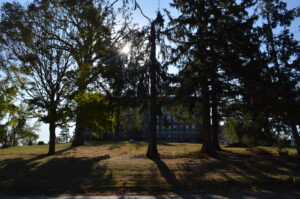
Sunlight filters through branches of a tree after the 2020 derecho in Cedar Rapids, Iowa. (photo/Cindy Hadish)
Iowa’s fall foliage landscape will take on a decidedly different look in parts of the state hit by the Aug. 10 hurricane-strength derecho.
Cedar Rapids, for example, lost an estimated 65 percent of its tree canopy in the storm, with winds up to 140 mph that uprooted century-old trees, twisted off treetops, bent tree trunks in half and broke off major limbs.
More: Photos from Iowa’s derecho windstorm
While the storm affected all varieties of trees, and therefore, all colors of fall foliage, spots where a multitude of golds, burgundy, blazing orange and red leaves brightened the city and other parts of Iowa in past seasons will be sadly barren this year and undoubtedly for years into the future.
The Iowa Department of Natural Resources notes that foliage is already turning at some points in the state, in part due to stress from Iowa’s 2020 drought.
See the curious trees blooming out of season after the derecho.
In the first of its weekly fall foliage reports, the DNR notes the following:
— Trees across the state are beginning to show color through the predominantly green canopy. Locations with the most color are along edges of wooded areas and bottomlands.
— In north central and northwest Iowa, trees are dappled with some color. Walnuts, cottonwoods, green ash and basswood are beginning to yellow. Red, orange, and purple are starting to become more prevalent in towns with maples and white ash trees.
— In southeast Iowa, yellow is starting in black walnut, silver maple, elm and cottonwood. Roadsides are showing some purple and reds from dogwood, wild plum and poison ivy.
— In west central and southwest Iowa, the last flush of prairie plants show yellow and purple blooms. Sumac, ivy and dogwood are colorful with purples, reds and oranges beginning to show.
Learn about some of the top native trees to plant in the Midwest.



[…] Related: Fall colors in post-derecho Iowa […]